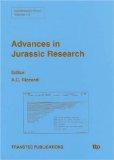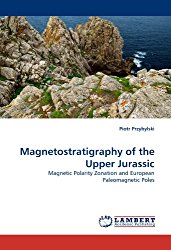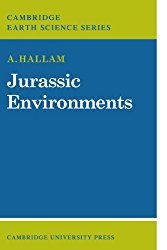Jurassic
- A complementary section for the proposed Toarcian (Lower Jurassic) global stratotype: The Almonacid de la Cuba section (Spain)

- A new chronology for the late Triassic to early Jurassic
- A potential global stratotype for the Sinemurian-Pliensbachian boundary (Lower Jurassic), Robin Hood's Bay, UK: ammonite faunas and isotope stratigraphy

- A potential stratotype for the Oxfordian/Kimmeridgian boundary: Staffin Bay, Isle of Skye, UK

- A U–Pb and 40Ar–39Ar time scale for the Jurassic

- Ammonite- and bivalve-based biostratigraphy and Panboreal correlation of the Volgian Stage

- Ammonite faunas of the Callovian-Oxfordian boundary interval in Europe and their relevance to the establishment of an Oxfordian GSSP

- An open ocean record of the Toarcian oceanic anoxic event

- Anomalies in global carbon cycling and extinction at the Triassic/Jurassic boundary: evidence from a marine C-isotope record

- Astronomical constraints on the duration of the early Jurassic Hettangian stage and recovery rates following the end-Triassic mass extinction (St. Audrie’s Bay/East Quantoxhead, UK)

- Astronomically-calibrated magnetostratigraphy of the Lower Jurassic marine successions at St. Audrie's Bay and East Quantoxhead (Hettangian-Sinemurian; Somerset, UK)

- Base of the Toarcian Stage of the Lower Jurassic defined by the Global Boundary Stratotype Section and Point (GSSP) at the Peniche Section (Portugal)

- Basinal restriction, black shales, Re-Os dating, and the Early Toarcian (Jurassic) oceanic anoxic event

- Candidate sections for the GSSP of the base of the Bathonian Stage (Middle Jurassic)

- Carbon isotope anomaly and other geochemical changes at the Triassic/Jurassic boundary from a marine section in Hungary

- Chemostratigraphy of the Jurassic System: Applications, limitations and implications for palaeoceanography

- Climate ups and downs in a disturbed Jurassic world

- Climatic fluctuations and seasonality during the Late Jurassic (Oxfordian-Early Kimmeridgian) inferred from δ18O of Paris Basin oyster shells

- Climatic ups and downs in a disturbed Jurassic world

- Continental Triassic-Jurassic boundary in central Pangea: Recent progress and preliminary report of an Ir anomaly

- Correlation of the zonal schemes at the Middle – Upper Oxfordian boundary (Jurassic) in the Submediterranean Province: Poland and Switzerland

- Dating the end-Triassic and Early Jurassic mass extinctions, correlative large igneous provinces, and isotopic events

- Depositional evolution of the Middle Jurassic carbonate sediments in the High-Tatric succession, Tatra Mountains, Western Carpathians, Poland

- Detailed record of the mid-Oxfordian (Late Jurassic) positive carbon-isotope excursion in two hemipelagic sections (France and Switzerland): A plate tectonic trigger?

- Distribution of clay minerals in Early Jurassic Peritethyan seas : palaeoclimatic significance inferred from multiproxy comparisons

- Early Toarcian (Early Jurassic) mass extinction linked to warming in Northern and Central Spain. Comparison with other sections of Western Europe

- Environmental conditions during the Toarcian Oceanic Anoxic Event (T-OAE) in the westernmost Tethys: influence of the regional context on a global phenomenon

- Evidence from Carbonate Platforms Bearing on Climate, Salinity, Dasycladalean Diversity, and Marine Anoxic Events During the Late Jurassic–Early Cretaceous Greenhouse

- Explosive eruption of coal and basalt and the end-Permian mass extinction
- Facies and climate/environmental changes recorded on a carbonate ramp: A sedimentological and geochemical approach on Middle Jurassic carbonates (Paris Basin, France)

- Fossil collecting in the Lower Jurassic
- Gallery of the Jurassic period
- Global Boundary Stratotype Section and Point (GSSP) for the base of the Pliensbachian Stage (Lower Jurassic), Wine Haven, Yorkshire, UK

- Global Jurassic tetrapod biochronology

- Hettangian Shallow Water Carbonates After The Triassic/jurassic Biocalcification Crisis: The Albenza Formation In The Western Southern Alps

- High-resolution dynamics of Early Jurassic marine extinctions: the case of Pliensbachian–Toarcian ammonites (Cephalopoda)

- IGCP 458 - Triassic-Jurassic boundary events
- Impact of Global Warming and Anoxia on Marine Benthic Community Dynamics: an Example from the Toarcian (Early Jurassic)

- Integrated stratigraphical study of the candidate Oxfordian Global Stratotype Section and Point (GSSP) at Redcliff Point, Weymouth, Dorset, UK

- Jurasic
- Jurassic
- Jurassic
- Jurassic dinoflagellate cyst zonation of Subboreal Northwest Europe

- Jurassic Global Stratotype Section and Points (GSSPs) – a potential serial World Heritage Site?

- Jurassic Microfossil Group - JMG - informal group of the International Subcommission on Jurassic Stratigraphy (ISJS).
- Jurassic of Iberia and Pery-Tethyan Basins - Spanish Mesozoic Group - the IVth Meeting on Stratigraphy and Paleogeography of the Spanish Jurassic
- Jurassic Period - ZoomDinosaurs.com
- Jurassic Period
- Jurassic Period
- Jurassic plants and climates
- Jurassic Reefs
- Jurassic System
- Jurské období
- Late Jurassic
- Late Jurassic-Early Cretaceous Timescales
- Late Jurassic sea-level fluctuations in NW Switzerland (Late Oxfordian to Late Kimmeridgian): closing the gap between the Boreal and Tethyan realm in Western Europe

- Late Triassic-earliest Jurassic geomagnetic polarity reference sequence from cyclic continental sediments of the Newark rift basin

- Lower Jurassic of Europe: its subdivision and correlation

- Magnetostratigraphy of the Jurassic/Cretaceous boundary interval in the Western Tethys and its correlations with other regions: a review

- Massive dissociation of gas hydrate during a Jurassic oceanic anoxic event

- Middle Jurassic of western and northern Europe: its subdivisions, geochronology and correlations

- Modeling evidences for global warming, Arctic seawater freshening, and sluggish oceanic circulation during the Early Toarcian anoxic event

- National Comission for Stratigraphy of Belgium - Subcommission Permian-Trias-Jurassic
- Nd isotope constraints on ocean circulation, paleoclimate, and continental drainage during the Jurassic breakup of Pangea

- Palaeoecologic significance of Late Jurassic trace fossils from the Boulonnais, N France

- Palaeoceanographic and palaeoclimatic reorganization around the Middle-Late Jurassic transition

- Palaeoclimatic oscillations in the Pliensbachian (Early Jurassic) of the Asturian Basin (Northern Spain)

- Plate tectonic trigger of changes in pCO(2) and climate in the Oxfordian (Late Jurassic): Carbon isotope and modeling evidence

- Pliensbachian/Toarcian boundary: the proposed GSSP of Peniche (Portugal)

- Polar record of Early Jurassic massive carbon injection

- Quest for refined calibration of the Jurassic time scale

- Report on the International Workshop for a Climatic, Biotic, and Tectonic, Pole-to-Pole Coring Transect of Triassic-Jurassic Pangea
- Sequence Stratigraphy, Carbon Isotopic Signature, and Dolomitization of a Late Jurassic Greenhouse Platform, Croatia

- Stratigraphical framework for the Middle Jurassic strata of Great Britain and the adjoining continental shelf

- Stratigraphy and palaeoenvironmental analysis of the Triassic-Jurassic transition in the western Southern Alps (Northern Italy)

- Stratigraphy, ichnology, and sedimentary environments of the Late Bajocian-Late Bathonian Kashafrud Formation, Northeastern Iran

- Stratigraphy of the Jurassic
- Strontium and carbon isotope stratigraphy of the Late Jurassic shallow marine limestone in western Palaeo-Pacific, northwest Borneo

- Synchrony between Early Jurassic extinction, oceanic anoxic event, and the Karoo–Ferrar flood basalt volcanism

- Triassic–Jurassic boundary events: problems, progress, possibilities

- Triassic–Jurassic boundary in Asturias (northern Spain): Palynological characterisation and facies

- Triassic-Jurassic Footprint Project
- Une page Web sur la période jurassique - A web page about jurassic period
- Upper Jurassic of Europe: its subdivision and correlation

- Upper Jurassic of Gräfenberg (Southern Germany): Implications for Microfacies Development and Relative Sea-Level Change

- Warm Middle Jurassic–Early Cretaceous high-latitude sea-surface temperatures from the Southern Ocean

- Water mass exchange and variations in seawater temperature in the NW Tethys during the Early Jurassic: evidence from neodymium and oxygen isotopes of fish teeth and belemnites

Books about Jurassic



